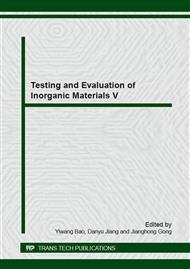p.140
p.145
p.149
p.154
p.159
p.165
p.169
p.173
p.179
Structural and Mineralogical Characterization of Green Nephrite in Hetian, Xinjiang, China
Abstract:
The green Hetian nephrite, which has delicate textures, spinach-like green and less cracks, contains three types of aggregates: primary nephrite, placer nephrite and Gobi nephrite. The deposits were located in the south part of the Tarim Basin, Xinjiang, China. In the orebodies of the deposits, primary nephrites occurr as veins or lenses along faults or fissures of adjacent ultramafic rocks. Samples with fine-grained and felted cohesive textures were collected from Hetian-Yutian County, Xinjiang Uyghur Autonomous Region, its mineralogical characteristics, H-O isotopic characteristics and forming mechanism have been discussed by means of SEM, EPMA, XRD, IR spectrum, Raman spectrum, DTA and TG study, and H-O isotope study. Microscopic observation and SEM show that green nephrite has interlocking-felted cryptocrystalline blastic texture with fine topography and high compactness. Tremolite, as a main mineral composition of the green nephrite, has high amounts of Si, Ca, and Mg; it turns into actinolite with the help of increasingly large amount of Fe. XRD, IR spectrum and Raman spectrum identified the occurrence of accessory minerals of chromite, chlorite, serpentine, clinopyroxene and apatite. DTA study demonstrates that the structure of tremolite was destroyed at 900 – 1100°C, while TG study demonstrates the tremolite has such little water that it lost only 0.89 – 1.33% of its weight when heated to 900 – 1100°C. The petrogenesis of green Hetian nephrite deposits are implied to be a result of metasomatic alteration of ultramafic-mafic rocks, and the black, spot-like chromite implies ultramafic-mafic rocks. The analysis of H-O isotope study indicates that the ore-forming hydrothermal fluids of Gobi nephrites are primary magmatic water, but details of hydrothermal fluids of primary and placer nephrites are still remained unknown and needed to be investigated furthermore.
Info:
Periodical:
Pages:
159-164
Citation:
Online since:
November 2014
Authors:
Price:
Сopyright:
© 2015 Trans Tech Publications Ltd. All Rights Reserved
Share:
Citation:


